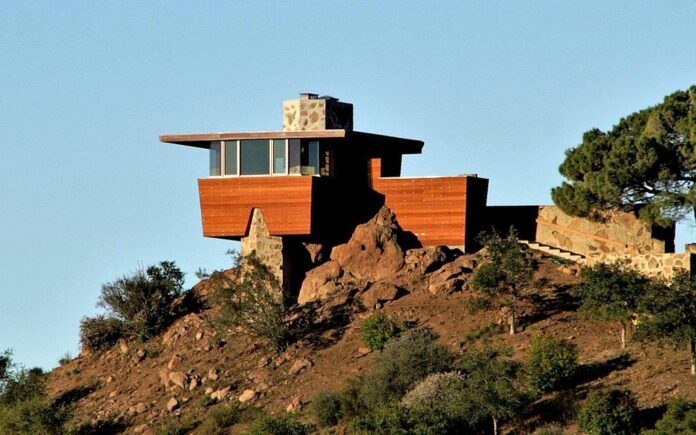Frank Lloyd Wright designed several extraordinary homes in the Los Angeles area in the early 20th century. Among them are the Hollyhock House in East Hollywood, a Mayan Revival home for arts patron and oil heiress Aline Barnsdall, and the Ennis House in the Los Feliz neighborhood, a 1920s home built from geometric concrete blocks and which remains one of the famed architect’s most iconic works.
Yet despite his affinity for Southern California, there has been only one Frank Lloyd Wright project known to exist in Malibu, the Pacific Palisades, or anywhere in the Santa Monica mountains or along the coast. That structure, the Arch Oboler Complex, burned down in the Woolsey Fire that swept through the area in 2018, threatening a number of major cultural sites including the Getty Villa.

The only other structure at the site, which the Obolers used as their primary residence, also burned down in the Woolsey Fire of 2018. Photo taken before the fire. Courtesy of The Agency.
Now comes a chance for the property, named Eaglefeather, to rise from the ashes. The 100-acre plot where the 1940 residence once stood has just come on the market for $7.45 million. It’s the first time in 25 years that the property has been up for sale. “The opportunity now exists to rebuild the 4,000-square-foot compound or begin anew,” according to the listing, which notes that by rebuilding the architect’s vision, new owners can “experience the genius of Wright firsthand.”

View of the complex from across the pond. Photo taken before the fire. Courtesy of The Agency.
Eaglefeather was originally commissioned by Arch Oboler, an acclaimed writer of radio shows and screenplays. Often compared to his contemporary, Orson Welles, with whom he shared a genius for dystopian storytelling, Oboler helped lead the entertainment industry’s transformation from radio to screen. He created the world’s first feature-length 3-D film, Bwana Devil (1952), and filmed another movie, Five (1950), in and around Eaglefeather.

Arch Oboler and his wife Eleanor with two chameleons they brought back from filming in Africa in 1948. (Photo by FPG/Archive Photos/Getty Images)
Oboler had become close friends with Wright in the 1940s and even pitched a documentary film about the architect. After the war, Wright designed the futuristic complex for Obeler, his wife Eleanor, and their four children. However, only two of the original structures were realized: the gatehouse (which, although not designed as the main house, was used by the Obolers as their primary residence) and a small nearby cabin called Eleanor’s retreat, perched on a rock outcropping. Arch Oboler lived on the premises until his death in 1987.

A drone image shows the Arch Oboler Complex as it appeared before the fire, including the gateway (center), Eleanor’s retreat (right), and a one-acre pond. Courtesy of The Agency.
Eaglefeather featured several of Wright’s signatures, including wood siding, red concrete flooring, and desert stone masonry. That foundational masonry was all that was left standing after the Woolsey Fire in 2018. Although the owners were instructed to demolish and remove the charred yet intact masonry as a safety measure, before any rebuilding could be done, the Frank Lloyd Wright Revival Initiative succeeded in petitioning the local government to waive that requirement.
Potential buyers wishing to continue Wright’s vision where the Obolers left off will need to build a film studio, which the architect included in his original plans. However, the property already comes with two modern conveniences—a fully functioning well and a solar-energy system—that survived the blaze.

























